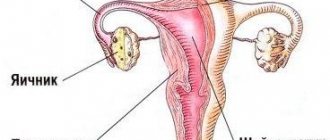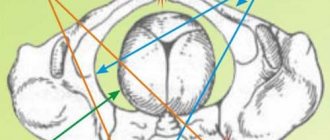Etiology of the phenomenon
If you are concerned about yellow discharge after childbirth, which is accompanied by fever and an unpleasant odor, then there is a suspicion of the development of an infectious disease or inflammatory process.
In this case, you must immediately consult a doctor and undergo an examination. It’s not for nothing that doctors advise women to take special care of their personal hygiene after the birth process. The fact is that the body can be very weakened. The immune system is weakened, and the birth canal is open.
The mother's body is designed in such a way that a wound remains at the placenta attachment site, which bleeds for some time. Therefore, the first days are the most difficult in this regard. A woman in labor needs to take special care of herself so as not to contract any infectious disease.
What personal hygiene should be like:
- It is necessary to keep sanitary pads clean and change them every 2 hours.
- After every trip to the toilet you need to wash yourself.
- It is necessary to empty the bladder on time, even if the urge is minor.
- You should not wear fashionable silk underwear. It is best to use loose-fitting cotton items at this time.
- Many women prefer to use tampons rather than pads. However, doctors strongly advise against doing this. The fact is that tampons prevent the natural release of fluid from the body. After the birth process, this can cause the development of serious inflammatory diseases.
- Douching is also best left until better times. In any case, there is no need to do this after birth permission.
However, in some cases, even despite the most careful adherence to personal hygiene rules, some women still experience yellow vaginal discharge after childbirth. When is this the norm, and when is it a pathology?
Prevention methods
This problem can be prevented.
- Doctors recommend leading an active lifestyle. As soon as the opportunity arises, you need to move more. Movement will provoke improved blood circulation and speed up the release of everything unnecessary. A woman who has just given birth should not ignore this rule. It is not necessary to visit the gym and exhaust yourself; walking with a stroller during the day is quite suitable for this purpose.
- It is important not to forget about the rules of personal intimate hygiene. Doctors strongly advise rinsing the vagina with warm boiled water or a herbal decoction after each visit to the restroom. For this purpose, it is better to use herbs against skin irritation; chamomile, sage, and calendula work well. Also, do not forget about regularly changing hygiene products (postpartum pads). Failure to promptly change such products may cause the development of bacteria or microbes.
- While taking a shower, you need to temporarily forget about fragrant gels and foams. It is better to give preference to antibacterial products without fragrances and dyes.
- It is also necessary to wear underwear made from natural fabrics (cotton), and ignore synthetics.
- It is extremely important for a girl to visit a gynecologist in a timely manner and report all suspicions and unpleasant symptoms.
Read also Hematometra after childbirth: what it is, signs, causes and treatment
You need to listen to the advice of medical professionals and get diagnosed on time, since self-medication can only worsen the well-being of a young mother.
Pathological causes
Postpartum discharge is an indicator of the natural self-cleaning of the uterus after the birth process. They occur regardless of the method of delivery - natural or surgical. Since the muscle layer of the uterus contracts in the first days after childbirth, heavy bleeding is absolutely normal.
If discharge after childbirth is accompanied by other unpleasant symptoms (for example, an increase in body temperature, a change in odor and consistency, the presence of impurities), this may indicate the development of inflammation or various gynecological diseases:
- Endometritis is a lesion of the uterine mucosa that is inflammatory in nature. This is one of the most common postpartum female diseases. In addition to the fact that endometritis is characterized by yellow and green discharge, it is also accompanied by increasing pain in the lower abdominal cavity and an increase in body temperature. Pathology can develop in the first days or several months after delivery.
- Inflammatory process in the appendages. Inflammation may be associated with endometritis or develop independently. In the absence of timely and effective treatment, it can acquire a chronic form, which can lead to serious complications - adhesions and infertility. With any inflammatory process in the internal genital organs, there is a possibility of accumulation of pus. If a woman ignores alarming symptoms, this can lead to an abscess of the abdominal organs.
- Cervical erosion. In some women, erosion on the cervical mucosa does not heal after childbirth. First of all, its presence is indicated by discharge. If a woman ignores this problem, the risk of infection will increase several times. In this case, the discharge changes color, structure, intensity, and the temperature rises.
- Lesion of the vagina (colpitis or vaginosis) after the birth process. Associated symptoms of these diseases are burning, itching, dry mucous membranes.
The complex of measures to prevent postpartum complications, including pathological discharge, includes:
- ban on hot baths and saunas for 3–4 months after delivery;
- abstinence from intimate relationships for 2 months;
- daily hygiene procedures (at least 2 times);
- frequent attachment of the baby to the breast;
- routine examinations with the treating gynecologist.
When should you worry? If your state of health after childbirth causes concern, it is better to consult a gynecologist. You should be especially wary if blood is present in the lochia for a long time.
Sometimes the development of a pathological process in a woman who has given birth can even have life-threatening consequences. Therefore, if symptoms such as:
- Fever.
- Sharp pain in the lower abdomen. You should be alarmed if not only your stomach hurts, but also your lower back.
- Pus with blood appeared in the lochia.
- The secret is green.
- There is burning and itching in the vaginal area.
Such symptoms may be a sign of developing endometritis. Therefore, in any case, it is necessary to urgently seek help from a hospital. The sooner a woman receives medical help, the less likely she is to develop serious and dangerous complications.
There is no need to worry if the yellow secretion becomes a little brighter even when a woman is taking birth control pills. They can also affect hormone levels in the body. However, if the green discharge after childbirth takes on a foamy or cheesy appearance, then the development of the disease should be suspected.
If lochia becomes abundant, then the development of an acute form of a bacterial disease can be suspected. Abundant yellow lochia may be symptoms of:
- Salpingitis is inflammation of the fallopian tubes. This disease develops due to the presence of pathogenic bacteria in the uterine cavity. Gradually, bacteria penetrate into the lower pelvic organs. Abundant yellow lochia may be symptoms of the acute form of this disease. In this case, the woman is bothered by painful urination. After intimacy with a partner, a bloody secretion may be present.
- Inflammation of the appendages. The acute form is accompanied by the release of pus, which is yellow in color. In this case, the woman suffers from irritation of the mucous membrane of the external genitalia. Frequent urination and pain during intimacy with a partner are often added to the unpleasant sensations. Often menstruation becomes extremely painful.
Yellow lochia with an unpleasant odor can be symptoms of other serious diseases. That is why it is necessary to visit a gynecologist more often after childbirth. In this case, many serious health consequences can be avoided.
The mechanism of childbirth is a serious stress for the body. Fetal rejection is accompanied by a large number of unpleasant and sometimes dangerous phenomena for the woman in labor and for the baby. Possible:
- bleeding;
- incomplete expulsion of the placenta;
- numerous breaks.
A natural component of postpartum recovery is lochia (you can see what they look like in the photo). The contents of the uterus are gradually released, it is cleansed.
It’s worth finding out in advance how long the discharge lasts after childbirth, so that you can be prepared for it and be alert in time if something goes wrong. Note that after an artificial birth (caesarean section), lochia may last a little longer. After the second and third births, the uterus will contract faster.
- What should they be?
- Discharge after childbirth: normal
- Yellow lochia
- Green lochia
- Brown and bloody lochia
- Mucus discharge
- Purulent lochia
- White discharge
- Pink discharge
- Lochia after childbirth: norm and deviations (by day)
Caesarean section (CS) is an abdominal surgical intervention, the purpose of which is artificial delivery. The fetus is removed through an incision in the anterior abdominal cavity and the wall of the uterus.
Many women mistakenly believe that, together with the baby and the placenta, the doctor also performs curettage during the operation.
Curettage is a surgical procedure during which, using an appropriate instrument or vacuum system, the mucous surface of the uterus is removed from foreign epithelial compounds.
This idea is completely wrong. Cleansing of the internal cavity occurs spontaneously with the help of lochia - mucous secretions that wash away postpartum “garbage” from the fallopian tubes. This process is quite lengthy, because during this period the uterus spontaneously decreases by more than 20 times. In fact, the cavity and the mucous membranes surrounding it are completely restored in the postoperative period, but before activating tissue regeneration processes, the body rejects dead particles remaining from the placenta and other epithelia that are not removed during cesarean section, which come out in the form of blood clots and mucus - lochia.
Breastfeeding helps produce the hormone oxytocin needed to speed up the process. Its “production” is accompanied by discomfort in the abdominal area. The production of this component in women who have undergone cesarean section. That is why additional administration of the hormone in the form of injections may be necessary.
Surgical delivery is a serious abdominal operation that requires not only postoperative treatment of sutures, but also special rules of personal hygiene and care for injured areas:
- In the first month after cesarean section, it is recommended to clean the perineum with each visit to the toilet. Depending on the situation, this could be a shower with baby soap or a special care product, a decoction of string, chamomile or calendula.
- During the first week after surgery, obstetricians strictly prohibit the use of pads familiar to women. This personal hygiene product creates a “diaper rash effect” and promotes the development of pathogenic bacteria. It is recommended to replace the usual attribute with ordinary diapers or pharmaceutical gauze, which have excellent “breathing” properties. But it is recommended to change improvised pads every 3-4 hours.
- To improve uterine contractions, gynecologists recommend, at least in the first month, lying on your stomach for 15–30 minutes.
- For the first few weeks after surgical delivery, it is recommended to apply an ice heating pad to the abdomen. This procedure is familiar to many women whose labor took place naturally. They were given a heating pad for several hours at once, and for those who had undergone a section, it was recommended to apply it for 5–10 minutes up to 5 times a day.
- Circular massage movements will also have a positive effect on the contractility of the uterine muscles and speed up the recovery process after cesarean section.
- Immediately after the operation, the woman in labor is recommended to wear a postpartum retaining bandage.
In the practice of a gynecologist, determining the nature of the patient’s vaginal discharge is of great importance in making a diagnosis, changes in which can signal various disorders in the woman’s body. It is necessary to take these changes into account in the context of the general condition of the body and analysis of additional symptoms of the observed pathology. The diagnosis is most often confirmed by laboratory tests. What to do if green discharge appears in women?
In women, discharge with a greenish tint is a consequence of inflammatory diseases of the vagina, cervix and uterine body, fallopian tubes and ovaries. Greenish discharge is determined by the admixture of leukocytes in the mucus. However, green discharge is not always due to the introduction of microbial agents.
Many women experience green, odorless discharge. If greenish, odorless discharge is observed, the reasons for this may be:
- allergic reaction of the vaginal mucosa to hygiene and care products, underwear, talc, etc.;
- reaction to wearing tight underwear (thongs, etc.);
- menstruation, before and after which light white and sometimes greenish discharge from the vagina is often observed.
A change in the shade of vaginal secretion can be observed at the beginning of sexual activity or when changing sexual partners. This may serve as a sign of adaptation to a new, unusual microflora. But most often, heavy discharge is the result of problems in the organs of the reproductive system. The reasons for the appearance of green discharge are varied. The appearance of pathological vaginal secretions can be provoked by: diabetes mellitus, prolapse of the vaginal walls, tumor and immune diseases.
Other reasons
In childhood, mucous discharge in girls begins about a year before the appearance of menstruation. As a rule, they are transparent. A change in the nature of vaginal secretions is a good reason to consult a gynecologist. The appearance of greenish discharge in women is common. If discharge appears after menstruation, this may be a marker of endometrial hyperplasia, uterine fibroids, and various cystic formations. It is necessary to consult a gynecologist about treatment tactics, since such symptoms can lead to infertility.
During pregnancy and after childbirth
During pregnancy, greenish discharge may occur as a variant of the norm. The reason is the hormonal changes in the female body during the period of gestation. However, if you experience smelly discharge, a burning sensation, irritation, or painful urination, you should consult a specialist. All of these symptoms may indicate vaginosis or infections in the vagina and other organs of the reproductive system.
Important! The most common etiological factors may be gardnerella, mycoplasma, trichomonas, gonococci and other pathogenic microbes. And in this case, you need to discuss therapy with your doctor.
Green vaginal discharge can persist for a long time after childbirth. During the first weeks, the uterus is cleansed and the discharge contains ichor. On average, urinary postpartum discharge lasts 6-8 weeks. After 2 months, green discharge after childbirth may disappear, it all depends on the individual characteristics of the female body. The appearance of yellow-green discharge after childbirth is a sign of the final cleansing of the uterus. In this case, the appearance of yellow-green discharge in a woman should not cause alarm. The appearance of discharge with a greenish tint, mixed with pus and blood, indicates the presence of endometriosis or a sexually transmitted infection.
If pregnancy is resolved by cesarean section, the postpartum period may have its own characteristics. Most often, discharge after cesarean section (lochia) is bloody and odorless. As a rule, they completely disappear by 21 days after cesarean section. If you still have bleeding a month after giving birth, you should consult a specialist.
Changes in color and odor are a sign of a postoperative complication. The cause of complications may be a narrowing of the cervical canal, planned childbirth, refusal of breastfeeding, or impaired contractile function of the uterus.
When is yellow lochia considered normal?
Some women, after giving birth, seeing discharge on their underwear that resembles menstrual discharge, begin to become very worried. What discharge is physiologically normal during the postpartum period, and how should the shade and volume of the discharge mass change? Below are the options for normal and pathological conditions depending on the period after birth.
| Postpartum period | Normal color | Pathology | Volume is normal | Pathology |
| During the first week | Bright red | Green or yellow | Abundant | Scarce |
| In 1 week | Brown, pink, brown-yellow with the presence of bloody clots | Deep red | Volume corresponding to menstrual flow | Too abundant or lack thereof |
| In 1 month | Mucous membranes are brown-yellow, light yellow with blood admixtures | Bright red | Minor volume | Abundant |
| After 2 months (in some cases - after 3 months) | Mucous membranes are white-yellow or transparent without bloody impurities | Red, brown | Minimum volume | Abundant |
Having a child is a natural process for the female body. After delivery, the placenta is separated. The place where it attaches then becomes an open, bleeding wound. It takes time for the body to recover. In general, you need to be prepared for the fact that lochia will appear immediately after the end of labor. If a woman is breastfeeding, the uterus will contract and repair faster.
It is considered normal if lochia lasts from a month to 6 weeks. However, do not be alarmed if the color of the secretion changes. This is also considered normal and does not require medical attention. During the first week or so, the lochia are bright red in color and abundant. Around day 11, the discharge will decrease and then turn into mucus.
Yellow secretion is also normal. Over time, the color will change and become white-yellow, and sometimes completely transparent. However, in some women the process of uterine contraction occurs more slowly, so yellowish lochia may last for about 2 months.
But this state of affairs is not considered a pathology. Even if there is yellow lochia with a small amount of blood, you should not be alarmed.
Sometimes lochia appears a month after the birth of the child. This is also considered a normal recovery process. But if lochia appears, which is accompanied by an increase in temperature, as well as painful sensations, then perhaps the development of an infectious disease or inflammatory process is taking place.
If a month has passed and nothing comes out of the uterus, you need to go to the doctor, even if you feel well. Has the nature of the discharge changed dramatically? Also a reason to visit a doctor. The normal duration of lochia separation is up to 8 weeks. Doctors say that the discharge goes away within 5 to 9 weeks - this also falls within the normal range.
These include:
- duration;
- character;
- the presence or absence of an unpleasant odor.
When the bloody and brown lochia ends, they lighten and gradually acquire a yellowish tint. Normally they have almost no odor. Yellow discharge after childbirth 2 months later, not at all abundant, gradually becoming transparent, doctors attribute it to one of the options for normal healing of the uterus.
They can be:
- yellow with a smell;
- liquid like water;
- jelly-like;
- smearing, sticky.
All of them require a medical examination. This kind of discharge can no longer be considered lochia - it is a sign of an infection in the body. Most often in this case they talk about the beginning - inflammation of the uterus. It needs to be treated at the earliest stages, when the temperature has not yet risen and the infection has not covered a large area of the inner layer of the uterus.
It may be easier for you to understand whether everything is proceeding within normal limits if you refer to the following summary table.
Table 2.
Period | Color and volume | Smell | What do they mean? |
| First days | Bright scarlet, burgundy, abundant | Normal bloody odor | Norm |
| Scanty, in small quantities, scarlet | Normal bloody odor | Dangerous sign: perhaps something is blocking the release of lochia; if the obstacle is not removed, inflammation and purulent itching will begin. Dangerous condition | |
| First week, from 3 to 5-10 days or a little longer | There are enough pads used for menstruation. Color brown, grey-brown. Possibly separated in “pieces”. Sometimes a slight increase. No rise in body temperature | Rotten smell | The uterus contracts - everything is going well, clots come out - normal |
| 35-42 day | Brown, gradually lightening, at the end of the period beige - will soon end. After which there will be ordinary transparent | Without smell | Norm |
| At any time | Green, yellow with an unpleasant odor, purulent. | Most often with an unpleasant odor, possible itching, pain, rise in body temperature | Pathology – consultation with a doctor is required |
| Possible at any time after 3 weeks | Transparent mucous membranes, abundant transparent | Without smell | Ovulation is a variant of the norm |
Surgical intervention in the birth process entails a protracted process of regeneration, which takes place not under the close supervision of a specialist, but at home, in parallel with caring for the child. Therefore, it is especially important to monitor the nature and intensity of physiological fluids rejected after cesarean section. Timely changes recorded will help prevent the development of pathological processes.
In the first days after the section, such symptoms should not cause concern to the woman in labor. These physiological fluids are associated with mechanical damage to tissues and blood vessels during contractions. It is necessary to carefully monitor the duration of this type of lochia after cesarean section.
The bloody substance must be rejected by the body within 7–8 days. Longer discharge and increasing volume may indicate that bleeding has begun!
The clots released during this period are particles of dead endometrium and the remains of the placenta. Their duration should also not exceed 7–8 days.
Pink lochia
Most often, this type of discharge appears a month to a month and a half after the CS. This sign is not called a physiological norm, but they also do not talk about the development of pathology. The presence of pink discharge is associated with a protracted process of regeneration of mucous tissues or, most often, injury to the surface of the uterus.
Brown lochia
Often women notice the appearance of these discharges 6–7 weeks after surgery. In their structure, they are closest to the usual menstrual spotting and are a physiological stage in the recovery process and do not indicate deviations.
Yellow discharge
This phenomenon is considered physiological only in the first 2–3 weeks and only if there is a poor consistency. An orange, smearing, viscous substance on a pad with a pungent odor indicates the initial stage of the development of endometritis, but abundant yellow mucous clots with putrid inclusions indicate an advanced stage of the disease, most often requiring surgical intervention.
Black lochia
If a woman in labor notices stains on the pad that do not have a specific odor, then, oddly enough, there is no need to sound the alarm. This substance is a physiological norm and its presence is dictated by hormonal changes in the composition and quality of blood.
White discharge
Such discharge without accompanying symptoms can begin at the stage of completion of the excretory process. But the emerging itching, redness, cheesy consistency and characteristic, sour smell require immediate diagnosis using a smear. These symptoms may indicate prolonged thrush.
Mucus, which is clearly visible in the discharge in the first days after cesarean section, is a physiological norm and cannot be present in it for a long time. Its appearance is associated with the excretion of the child’s intrauterine waste products from the body.
Watery lochia
Having noticed an abundant clear liquid, the consistency of which resembles urine and gives off an unpleasant odor associated with rotten fish, a woman should inform her gynecologist about this. Symptoms require immediate medical intervention. Such manifestations are typical in cases of serious injury to the circulatory system or lymph.
Yellow discharge after childbirth is almost never a pathology. They can occur at the final stage of uterine restoration, but their color should not be pronounced. In addition, they should not be accompanied by an unpleasant odor. When is yellow mucous discharge after childbirth a sign of pathology?
Only in cases where they are accompanied by an increase in body temperature, pain in the lower abdomen, green pus, burning and itching in the genital area. Such discharge may be a sign of endometritis - inflammation of the uterine mucosa. In this case, you should immediately consult a doctor for a course of treatment.
How to avoid complications during the postpartum period?
To speed up the recovery process and not interfere with normal cleansing, some important points should be observed. It is necessary not to delay urination and avoid constipation in order to avoid pressure on the uterus. Young mothers are recommended to sleep and rest on their stomachs. This promotes better muscle contraction.
After giving birth, you should not use tampons. They absorb dirt, which creates favorable conditions for pathogenic microflora. There are special pads for women who have given birth. Preference should be given to hygiene products without fragrances. Such substances can cause allergies. They also make it difficult to evaluate the smell of discharge, which is very important.
Intimate hygiene should be treated with special attention. It is recommended to wash as often as possible. You can't take a bath. Water procedures are only permissible in the shower, and it is important to ensure that the stream of water does not enter the vagina.
Women who have recently given birth are advised to have sexual rest. It should last until the lochia is completely resolved. You can return to sex only after a follow-up medical examination and selection of a contraceptive.
Cleansing the uterus after childbirth is an important point in restoring the body. The nature and duration of discharge help to identify pathological processes in time. This is why it is important to note the color, smell and consistency of the lochia until it is completed.
Pink postpartum discharge
Discharge of a pinkish tint may be due to the presence of erosion, minor injuries to the genital tract that occurred during childbirth, or diseases such as the uterus, suture dehiscence. In any case, you should visit a doctor to determine the cause.
Postpartum discharge is a natural occurrence, so if there are no signs of any abnormality, there is no need to worry. Each postpartum period has its own norm. For example, in the first 7 days after the baby is born, the mother may have bright red or brownish-red lochia. After a month - transparent, odorless or light yellow discharge.
White discharge indicates a fungal infection of the genital organs. After childbirth, women often develop thrush due to weakened immunity. The curdled consistency and sour smell of the discharged mass are the first signs of candidiasis. A woman’s weak body, as a rule, cannot cope with this disease on its own, so for treatment you should consult a gynecologist.
In rare cases, white discharge is a natural secretion of the mucous membrane and has a uniform, odorless consistency.
Green discharge
Green discharge indicates the development of pathology after childbirth, for example, infection. Greenish lochia is accompanied by pain and fever, and can cause bleeding. The causes of green lochia include:
- accumulation of blood clots in the uterine cavity;
- severe tears and cracks in the perineal area;
- remnants of placenta in the uterus.
Bloody discharge in the first weeks after the birth process should not frighten the woman in labor. During this period, the uterus intensively cleanses itself, so lochia mixed with blood is the norm. After 7–20 days, the discharge becomes darker and turns brown. This period lasts no longer than a month.
Treatment
The following drugs and their analogues are indicated for the treatment of candidiasis:
- "Ciclopirox" ("Dafnedzhin");
- "Clotrimazole" ("Antifungol", "Canesten", "Kanizon", "Clotrimazole");
- "Isoconazole" ("Gyno-travogen Ovulum");
- "Miconazole" ("Ginezol 7", "Gyno-daktarin", "Klion-D 100");
- "Natamycin" ("Pimafucin");
- "Nystatin" ("Makmiror Complex", "Terzhinan").
Flucostat tablets are prescribed orally. After antimycotic therapy, the woman is shown drugs that restore intestinal microflora.
Treatment of gonorrhea is carried out with drugs in tablet form (Cefixime, Ciproflexacin, Ofloxacin) and in the form of intramuscular injections (Ceftriaxone, Spectonomycin), depending on whether the doctor is dealing with an acute or chronic infection. If more than 2 months have passed since the disease, then preference is given to intramuscular injections. At the same time, local drugs are prescribed, and therapy to correct immunity is carried out.
Important!
The impact on other etiotropic factors of inflammation of the organs of the reproductive system is carried out taking into account the type of pathogen, level of damage, stage of infection, the presence of general symptoms and complications.
It is highly undesirable to self-medicate. Inadequate selection of a drug and its dose can lead to a false choice, which will not cause harm to the pathogen, but will change the normal microflora of the genital tract. An insufficient dose can lead to the formation of a resistant strain of the microorganism, which will subsequently be difficult to treat. And, on the contrary, an overdose can lead to allergies, dysbiosis and complications from internal organs.
After childbirth they occur quite often. For many women, this raises a lot of questions: is this normal or should you see a doctor? Read more about this in our article.
Brown discharge after childbirth
Immediately after childbirth, the inner walls of the uterus are a continuous wound surface. It is easy to understand why so much bloody content is released in the first days after birth. The muscle layer of the uterus contracts, and naturally, under the influence of oxytocin, blood vessels contract, triggering blood clotting mechanisms and stopping bleeding. These are natural consequences of having a baby.
At first, the discharge can be called pure blood - at least that's what it looks like. This is fine. Their duration takes from 2 to 3 days. Everything that begins later no longer seems like bleeding - the nature of the lochia (as postpartum discharge is called) changes.
Bloody discharge should not last long. Bloody and dark red should end within a few days at the latest. The most dangerous hours are considered to be the first hours after the birth of the baby, when the uterus is still, in fact, a continuous bleeding wound. At this time, bleeding may occur. Doctors carefully monitor the condition of the woman in labor and send her to the postpartum ward, place an ice pack wrapped in cloth on the lower abdomen, give an injection of oxytocin, and put the baby to the chest. Intensive observation lasts 1.5-2 hours.
After a caesarean section, just like after a natural birth, bloody lochia is observed. Only the process of uterine involution may be slower due to the suture, and therefore they may last a little longer. After cleaning the uterus, if the placenta did not come out on its own, there will also be spotting.
Brown discharge after childbirth 2 months later is possibly a pathological reaction of the body. This is how the clotted blood comes out. There can be many reasons - from hormonal imbalance to menstruation that begins to recover (if the mother does not breastfeed), the nature of which may be unusual at first, since the hormonal background has changed. The reason may be .
If two months have passed after delivery and you notice spotting, even if the baby is breastfed, you need to consult a doctor. Either a new menstrual cycle begins, or a serious inflammatory process occurs. Moreover, it may not even be accompanied by pain.
Possible presence of tumors, polyps, appearance. When the discharge stops and suddenly starts again, this is a reason for examination in any case. If it is confirmed that this is menstrual flow, you need to protect yourself. You need to know that with the restoration of the cycle appear. During menstruation, the amount of milk may decrease. You need to be patient and continue breastfeeding. Use supplementary feeding only in extreme cases.
Usually, light or dark brown discharge after childbirth causes new mothers to panic. But there is no need to be afraid. This is just one of the stages in the release of lochia from the body. Approximately 8-9 days after birth, the dark shade of the discharge changes to a lighter shade: yellow-transparent. At this point, bloody veins practically do not appear in the lochia.
What does spotting mean?
The baby decided to be born, the birth was successful, there were no visible complications, but after two months there is still spotting? If there are no disturbing symptoms, such as fever, abdominal pain and general deterioration of the condition, we can talk about slow contractions of the uterus. That is, the organ has not yet returned to its previous size, has not been cleared of ichor, mucus, or exfoliated epithelium. Each woman has her own rate of shrinkage and cleansing of the uterus, and much depends on how enlarged it was during pregnancy.
Bloody discharge 2 months after birth is normal if it gradually decreases and is not accompanied by unpleasant sensations.
To improve uterine contractions, you should breastfeed regularly - this process activates the production of oxytocin, which stimulates smooth muscles. In addition, doctors advise lying on your stomach more often. However, after giving birth, women do this with pleasure, because they were deprived of this opportunity for many months.
Cold compresses in the first weeks after childbirth also contribute to the contraction of the uterus, which means its rapid return to normal. A sign that everything has returned to its original state is transparent discharge, which may immediately have a yellowish color.
What to do?
If a woman in labor finds pathological discharge on her underwear, she should immediately contact a gynecologist. In this case, doctors examine the patient and refer her for additional diagnostics - ultrasound examination of the pelvic organs, smear for microflora, etc. Treatment of the pathological condition, which, for example, manifests itself in the form of green lochia, includes antibacterial therapy and physiotherapy.
The most dangerous for women’s health are deep red or bright pink lochia, characterized by abundance and lingering nature. In this case, doctors recommend applying ice to the lower abdominal cavity. If a woman in labor is bothered by copious mucous discharge that looks like snot, she needs to receive an injection of Oxytocin to activate the contractile activity of the uterus.
Discharge with odor
The smell of discharge after childbirth is a significant characteristic of it. If we talk about the norm, then immediately after childbirth the discharge smells like blood. This is natural: the main component is blood. After 7 days, when the scarlet and brown discharge ends, the smell becomes musty.
You should be wary if there is discharge with an unpleasant odor; the reasons for this may lie in the disease. Women rate the smell differently: “Smelly”, “Smells bad”, “Smells rotten”, “Smells fishy”. All these are bad symptoms. Discharge, even light, with an unpleasant odor, is a reason to visit a doctor.
Not only the color and consistency, but also the characteristic smell of vaginal fluids can tell a lot about the quality of the postpartum process.
Discharge accompanied by a characteristic odor during the first 3–5 days after cesarean can be considered a physiological norm.
The presence of a sharp, “heavy” aroma in smears is the first sign of the onset of an inflammatory process in the uterine area. Typically, such odors are caused by the introduction and spread of pathogenic bacteria.
Prolonged symptoms, accompanied by a sour aroma, indicate inflammation of the uterine mucosa and, most often, are accompanied by sharp, cutting pain in the lower abdomen and perineum.
Yellow discharge: normal or not?
It is believed that a woman who breastfeeds her baby goes through the stage of postpartum discharge much faster. The uterus contracts more intensely, and therefore returns to its postpartum state more quickly. However, during this period, girls need to be as careful as possible in terms of their hygiene. Yellow discharge may appear precisely when this rule is not followed. In addition, doctors strictly prohibit the use of anything other than pads. For example, tampons. They delay the normal process of cleansing the uterine cavity. During normal menstruation, this is not critical, but immediately after the birth process, blood should flow freely.
In most cases, yellow discharge is normal. Especially during the period when lochia ends. The blood mixes with the secretion, sometimes acquiring a yellowish tint. If there is no smell, pain or itching, then most likely there is no need to worry.
It happens that even at the final stage of postpartum discharge, a woman notices streaks of blood on the pad. This is also normal because the uterus needs quite a long time to heal.
Green discharge after childbirth
Green discharge after childbirth 2 months or earlier is a sign that something is wrong in the body. Lochia of this color is not normal at any stage. Greenish or yellow-green lochia indicates that there is a bacterial infection in the uterus, vagina, or fallopian tubes. If you do not deal with it in time, endometritis may begin - a disease that causes inflammation of the inner lining of the uterus.
They happen when:
- gardnellese;
- gonorrhea;
- chlamydia.
Trichomoniasis often causes discharge of this shade. Trichomonas settles in the vagina, and it is dangerous because if left untreated, the infection rises higher.
The first signs of trichomoniasis:
- green color;
- foamy character;
In addition, the woman will feel a burning sensation in the vagina and irritation. The mucous membranes may turn red. If you start treatment immediately, without delaying, you can quickly cope with the disease and prevent the infection from spreading further.
Yellow-green discharge or green discharge after childbirth is a clear sign of pathology in the body of a young mother. Especially if they are accompanied by an unpleasant putrid odor. Typically, this type of discharge indicates the development of endometritis - inflammation of the uterine mucosa, as well as other gynecological diseases. Green color is an admixture of pus in the lochia.
If such discharge appears, accompanied by chills and fever, you should immediately consult a doctor.
In addition to endometritis, green lochia can be a sign of poor uterine contractions. If the discharge does not come out well, it can accumulate in the uterus and fester, resulting in inflammation. In this case, the young mother may need curettage.
Is yellow vaginal discharge after childbirth a physiological norm?..
As you probably know, in the last stage of the current labor, the birth of the placenta should normally occur, directly at the site of the previous attachment, which subsequently forms an open wound.
Of course, the wound will always bleed until it can completely heal. Naturally, for the first time after childbirth, a bloody postpartum secretion - or lochia - will be released from the vagina. In most cases, yellow discharge appearing a month or two after birth is absolutely normal. Especially if such discharge appears immediately at the final stage of lochia release, if it is not too brightly colored, and is not accompanied by any additional, possibly painful sensations or signs of disease, such as itching, burning or even an increase in body temperature.
The so-called “white” lochia begins 7-10 days after birth. They are transparent or white, stretchy. Also, many women compare them to snot. There shouldn’t be any unpleasant odor, much less a high temperature! The main cause of mucous discharge is fluid that passes through the blood vessels and lymph nodes:
- Uterine cells are capable of secreting transudate;
- During ovulation, mucus leaves the cervical canal;
- The cervix has the ability to secrete.
It is noted that the cells are especially active in the second phase of the menstrual cycle, at the time of ovulation and a few days before it. This happens under the influence of hormones. This ensures better lubrication and the environment in the vagina becomes less aggressive for sperm. The mucus that clogged the cervical canal and cervix in the first half of the cycle begins to move away and is released.
Mucous discharge after childbirth
It is normal to have a small amount of mucus discharge a week after the baby is born. At this time, the mother’s body, or rather the uterus, continues to cleanse itself, and the work of the mucous membranes of the genital organs, which produce mucus, is restored. Over the next week their volume decreases.
Further, the appearance of mucous discharge, when the lochia has almost disappeared, may indicate ovulation. At the same time, they are thick mucous, similar to egg white. If the mother is breastfeeding, but has already introduced complementary foods, ovulation can most likely occur within 2-3 months. In non-breastfeeding women, the process of egg maturation begins again after the second month or even earlier.
See a doctor immediately!
If a woman is attentive to her health, then an infection that could get into the vagina will be cured quickly enough. However, if you start this process, the consequences can be disastrous. The most harmless disease is cervical erosion in the initial stage. But if it is not diagnosed and treated in time, it can turn into a malignant form.
Reduced immunity of a young mother can lead to thrush or colpitis. In this case, the discharge will not just be yellow, but also have a cheesy consistency.
Purulent discharge after cesarean section
An extremely dangerous symptom is purulent discharge after childbirth, whenever it occurs: after a month, after 3 months, after 7 weeks. Purulent discharge is one of the leading symptoms of inflammation. Possible endometritis or salpino-oophoritis.
In this case, it is often noted:
- weakness;
- fatigue;
- headache;
- lower abdominal pain;
- hyperthermia – increased body temperature.
This type of physiological fluid is the most dangerous and indicates not just a deviation during the postpartum period, but the development of a serious disease inside the uterine cavity - endometritis. after cesarean section they can occur at any stage of recovery. Often, accompanying signs of putrefactive processes on the mucous membrane are an unpleasant odor of the substance, increased temperature and acute pain in the lower abdomen.
Trichomoniasis
This disease indicates inflammation of the genitourinary system. Most often, it is transmitted sexually.
This is a complex of non-infectious, non-inflammatory pathological changes with the participation of anaerobic microflora. Most often, this phenomenon can be caused by a sharp hormonal change in the body and a dysbiotic shift. At the initial stages of development, the disease manifests itself as gray discharge with a sharp, disgusting odor, itching and burning in the groin area. The presence of thick, viscous, rich green discharge indicates advanced disease and the need to use antibiotics.
These infectious diseases are, first of all, characterized by spotting, light discharge of a greenish tint and purulent properties. Accompanied by constant nagging pain in the lower abdomen and problematic urination, aggravated by sharp pain.
Colpite
This infectious fungal disease is accompanied not just by greenish smears, but by copious mucous discharge of a purulent nature mixed with blood, severe itching and burning in the perineum.
Please note that whatever the cause of the appearance of purulent substances after cesarean section, such symptoms require immediate antibiotic intervention! An advanced problem can bring a woman to the operating table for curettage.
Duration
Every inexperienced woman in labor is interested in how many days the discharge lasts after childbirth. Uninformed women panic when they last longer than their normal period. This comes from ignorance of the physiology of this process. The purpose of menstruation is to release the “unused” egg. Lochia cleanses the uterine cavity, promoting its rapid contraction. Therefore, their duration is much longer. Normally it is from three to eight weeks. For some girls, especially young ones, this process may go faster. If the discharge lasts longer than expected, you should consult a doctor. It is possible that this process was complicated by bleeding.
There are cases when a woman gives birth with internal ruptures. At the same time, she should not actively move or even sit to avoid damage to the seams. However, not everyone manages to follow such a strict rule. In this case, the stitches tear and begin to bleed.
The closer to completion the process of lochia secretion, the lighter they become. Pain in the abdomen disappears, secretion becomes less abundant. If a month after giving birth the discharge is yellow, you should not be alarmed. This is a normal phenomenon that predicts the imminent end of lochia.
White discharge after childbirth
White discharge after childbirth is a sign of thrush, which tends to worsen with any fluctuations in immunity. The main symptom of thrush is the curdled consistency of the discharge. There is no point in delaying its treatment: in itself it is not dangerous, but it can provoke the penetration of inflammation along the ascending path, and then a bacterial infection is likely to occur. Untreated candidiasis causes significant discomfort to the mother.
Thrush is difficult to confuse with other diseases: it manifests itself in addition to the characteristic cheesy discharge with a sour odor, itching and burning, as well as constant irritation in the vaginal area. Why doesn't this discharge go away on its own? The body is weakened, it is difficult for it to cope with the multiplying fungus, the local immunity cannot cope - help is needed.
The appearance of discharge with the smell of fish indicates dysbiosis and the appearance of gardnerella. Gardnerella is an opportunistic organism that is constantly present on the vaginal mucosa. But under favorable conditions, its reproduction is not inhibited, and itching and odor appear. Often its reproduction occurs against the background of thrush.
As already written above, dark discharge after childbirth gradually changes to lighter ones. At first, the lochia becomes yellow, and then white and transparent. Clear discharge begins around the 10th day after birth and lasts about three weeks. They can have not only white, but also a yellowish-white tint. Such lochia is not a sign of the presence of a disease in the female body.










